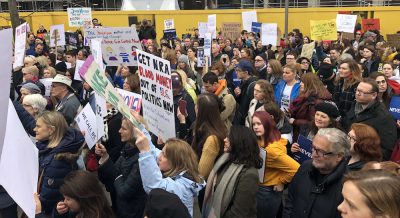
As someone who attended the March for Our Lives protest at the American Embassy on March 24, I experienced the raw emotions of that day. One of the most moving moments was when everyone was asked to lie down on the ground to represent all of the people killed in school shootings over the years.
After the three minutes had passed, everyone’s eyes who were filled with tears were flooded with anger and empowerment once more. And our ears were filled with inspiration and goals for the future. Lying on the concrete, I saw an old woman with tears streaming down her cheeks. I said nothing as I squeeze Dylan Petrillo’s hand and felt one single tear roll down the side of my face. These three long minutes were a very emotional and powerful time for reflection.
The ultimate goal for everyone is to stop anything like the shooting in Parkland from ever happening again. However, like everything else, people have very different views on how to resolve this issue.
It just so happens that politicians’ viewpoints seem to be drastically different than many survivors as well as many other citizens of the US and globally. It is argued by many politicians that school/mass shootings are the cause of mental health issues and that it is not a “gun problem.” Many of the school shooters indeed had some type of mental illness. However, it is argued by many others that if the mentally ill, along with other potentially dangerous persons did not have access to firearms there would be fewer cases of gun violence.
This claim is backed up by many scientific studies. Studies have shown that increased legislation on gun control, background checks, and age restrictions would reduce gun violence greatly. For example, since Australia’s Port Arthur massacre on April 28-29 1996, there hasn’t been a single mass shooting and gun homicides have reduced greatly in Australia. This is because two weeks after Port Arthur, all six Australian states agreed to enact gun laws prohibiting semi-automatics and shotguns.
Despite the evidence, many people still say that gun reform won’t make a change, that it won’t decrease gun violence. In effect, the NRA continues to advocate for the continued use of military grade weapons including semi-automatic rifles and accessories which make semi-automatic weapons fully automatic such as bumpstocks. The NRA often endorse federal lawmakers, and members of Congress receive donations from the NRA. These congressmen and women are the ones preventing gun reform legislation which ensures higher profits for gun makers. And therefore they have not created any bills regarding gun control. This is because if congressmen and women try to pass stricter gun laws, the NRA would use their political influence to those people voted out of office. The chant “vote them out” was referring to voting the congressmen and women out of office if they do no start creating legislation for gun reform.
One major change that student activists from the Parkland shooting are fighting for is the type of firearm available for purchase. The second amendment “The right to bear arms” was created in 1791. During this time, citizens of the United States were in fear of a tyrannical government and lacked a federal army. Consequently, Congress created the second amendment to the Bill of Rights for self defense. Firearms in the 1700s were rifles which took nearly two minutes to reload and only fired three shots a minute. Now, there is a federal army and it is possible to fire up to 800 rounds a minute when using a semi automatic rifle. In most major mass shootings, semi-automatic weapons are the weapon of choice. In 1994, the AWB (Assault Weapon Ban) was enacted, however, it only lasted 10 years as it expired in 2004. The AWB was not entirely successful, however, activists are looking for improved variations of legislation similar to the AWB.
On a personal level, I do not understand why someone feels it is necessary to have a military grade rifle for protection. And quite frankly I find it sad how politicians are unable to run a country where its people do not feel safe walking the streets unarmed.
Eighth grader George Stevens said “the second amendment was originally in place for a volunteer militia as no army existed in the US at the time. Now there is an army and the second amendment has lost its meaning and has lead to an increase in deaths due to firearms. The ability to purchase semi-automatic weapons and bump-stocks which makes them fully automatic is wrong and unnecessary.”
This was a topic stressed during the March along with other intentions for change. Being part of a group that has the same passion for change made me feel empowered and confident to stand up for what I believe in. Having so many people come together to fight for what we think is right has only fueled my inspiration to make a change.
Even people who were not at the march were impacted by news of this latest shooting. Eighth grader Owen Humphries said, “the special thing about the Parkland shooting is that it has really started a movement that has brought hundreds of thousands of people together. They’ve spoken with politicians and put them in a situation that makes them think about the problem.”
The March for Our Lives movement has proved to me along with millions on a global scale that change can be made. That change can be made by anyone who cares enough. That great change will be made if we all come together to fight for what is right.
